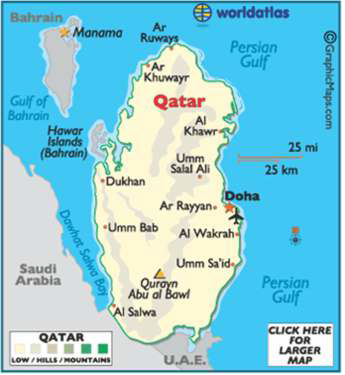FIFA World Cup 2022
 Author: STC
Author: STC
Article Date: 01.07.2017
The FIFA World Cup 2022 is the 22nd edition of the FIFA World Cup, the quadrennial international men's football championship contested by the national teams of the member associations of FIFA. It is scheduled to take place in Qatar in 2022. This will be the first time the World Cup will be held in the Middle East, and in an Arab and a majority-Muslim country. This tournament will be the last one to involve 32 national teams, including the host nation, as the next one will have 48 teams.
This will also mark the first World Cup not to be held in June or July; the tournament is instead scheduled for late November till mid-December. It is to be played in a reduced timeframe of around 28 days, with the final being held on 18 December 2022, which is also Qatar National Day.
Emir Sheikh Tamim bin Hamad al-Thani took over from his father in a peaceful transfer of power in June 2013. He is deputy commander of the armed forces and head of the National Olympic Committee, and in recent years had taken on increasing military and security responsibilities.
As of 2012, Qatar has proven oil reserves of 15 billion barrels and gas fields that account for more than 13% of the global resource. As a result, it is the richest state per-capita in the world. None of its 2 million residents live below the poverty line and less than 1% are unemployed.
Qatar's economy was in a downturn from 1982 to 1989. OPEC quotas on crude oil production, the lower price for oil, and the generally unpromising outlook on international markets reduced oil earnings. In turn, the Qatari government's spending plans had to be cut to match lower income. The resulting recessionary local business climate caused many firms to lay off expatriate staff. With the economy recovering in the 1990s, expatriate population, particularly from Egypt and South Asia, have grown again.
Oil production will not long remain at peak levels of 80,000 m³ per day, as oil fields are projected to be mostly depleted by 2023. However, large natural gas reserves have been located off Qatar's northeast coast. Qatar's proved reserves of gas are the third-largest in the world, exceeding 7,000 km³. The economy was boosted in 1991 by completion of the $1.5-billion Phase I of North Field gas development. In 1996, the Qatar gas project began exporting liquefied natural gas (LNG) to Japan. Further phases of North Field gas development costing billions of dollars are in various stages of planning and development.
Qatar's heavy industrial projects, all based in Umm Said, include a refinery with a 8,000 m³ per day capacity, a fertiliser plant for urea and ammonia, a steel plant, and a petrochemical plant. All these industries use gas for fuel. Most are joint ventures between European and Japanese firms and the state-owned Qatar General Petroleum Corporation (QGPC). The US is the major equipment supplier for Qatar's oil and gas industry, and US companies are playing a major role in North Field gas development. Qatar's National Vision 2030 has made investment in renewable resources a major goal for the country over the next two decades. Qatar pursues a vigorous programme of "Qatarisation", under which all joint venture industries and government departments strive to move Qatari nationals into positions of greater authority. Growing numbers of foreign-educated Qataris, including many educated in the US, are returning home to assume key positions formerly occupied by expatriates. To control the influx of expatriate workers, Qatar has tightened the recruitment of its foreign manpower programmes over the past several years. Security is the principal basis for Qatar's strict entry and immigration rules and regulations.
Statistics for 2015
Population (million inhabitants) 2.421
Land area (1,000 sq km) 12
Population density (inhabitants per sq km) 210
GDP per capita ($) 68,765
GDP at market prices (million $) 166,484
Value of exports (million $) 77,294
Value of petroleum exports (million $) 28,303
Current account balance (million $) 13,751
Proven crude oil reserves (million barrels) 25,244
Proven natural gas reserves (billion cum) 24,299.1
Crude oil production (1,000 b/d) 656.0
Marketed production of natural gas
(million cum) 178,472.0
Refinery capacity (1,000 b/d) 283.0
Output of refined petroleum
products (1,000 b/d) 611.3
Oil demand (1,000 b/d) 206.0
Crude oil exports (1,000 b/d) 490.7
Exports of petroleum products (1,000 b/d) 521.0
Natural gas exports (million cum) 129,877.2
Life expectancy (years) 78.5